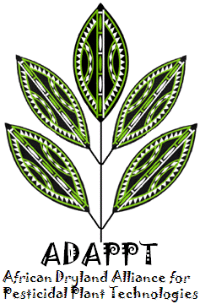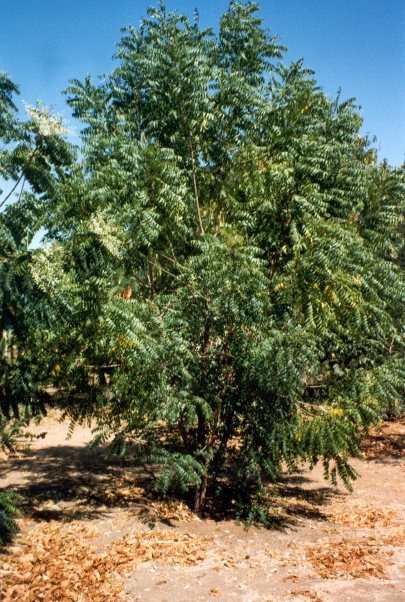Meliaceae
General
Azadirachta indica fact sheet (ICRAF)
Neem is a fast-growing tree which is native to the Indian subcontinent, where its medical and insecticidal properties are well known. It is widely distributed throughout Southeast Asia, East and Sub-Sahelian Africa, Fiji, Mauritius and parts of Central America. It grows well in climates from semi-arid to semi-humid and will thrive even in places with less than 500 mm of rain per year. Its soil requirements are modest and neem grows equally well on poor, shallow, sandy or stony soil. The trees fruit when they are 4-5 years old, yielding on average 30-50 kg of fruits per tree. The oil content of the seeds is between 35 and 45%. The effective ingredients are present in all parts of the tree but are most highly concentrated in the seeds.
Pest control using extracts from the neem tree is currently practised in more than 55 countries throughout the world, and neem products have been in use in parts of Asia, such as Burma and India, for over 2,500 years.
Plant parts with insect-controlling properties
-
Seeds
The seeds should be dried well so that they do not produce the toxic aflatoxins which impair their pest control properties and which are highly toxic to humans. When harvesting neem seeds, care must be taken that the fruit colour is neither greenish-yellow nor brownish-yellow but plain absolute yellow. Greenish yellow fruits are not fully mature and are low in azadirachtin content. For the collection of the fruits, spread a plastic sheet or cloth under the tree. Thus the seeds do not come in contact with the soil and the danger of fungus attack and aflatoxin development is reduced. After collection, the fruit pulp should be removed. The seeds are then dried for one day in the sun, and the following three days in the shade, during which they are regularly stirred. Stored neem kernels should be kept in well aerated containers or jute bags to prevent mould, which reduces effectiveness and produces highly toxic aflatoxins. Seeds between 3 and 8-10 months after harvest have the highest quantity of azadirachtin. Germination of neem seeds will decrease about one month after harvest and if exposed to temperatures higher than 45C.
-
Leaves
The advantage of using neem leaves lies in the fact that leaves are available all year round and do not have to be processed for storage. It is reported that a mature tree of about 8-10 m in height can produce about 360 kg of fresh leaves per year.
The insect-controlling substances are primarily azadirachtin A and B. In addition, neem contains a number of other chemical substances such as Salannin and Meliantriol, which have primarily repellent effects, and Nimbin/Nimbidin, which seem to have antiviral effects. Some substances support each other, thus creating synergistic effects.
Mode of action
Insecticidal, repellent, antifeedant, acaricidal, growth-inhibiting, nematocidal, fungicidal, antiviral
Neem compounds act mainly as a stomach poison and systemic.
Target organisms
The compounds are most effective against insects of the following orders:
Coleoptera (beetles and their larvae), Lepidoptera (caterpillars = larvae of butterflies and moths), Orthoptera (nymphs and adults of grasshoppers and locusts). Results against some bugs, leafhoppers and whiteflies have also been good.
| Field insects | |
| American bollworm | Helicoverpa armigera |
| Ants | general |
| Banana pseudostem borer | Odoiporus longicollis |
| Bean pod borer | Maruca testulalis |
| Brown rice planthopper | Nilaparvata lugens |
| Bunch caterpillar | Andraca bipunctata |
| Cabbage worm | Mamestra brassicae |
| Citrus leaf miner | Phyllocnistis citrella |
| Cockchafer grub | Lachnosterna impressa |
| Colorado beetle | Leptinotarsa decemlineata |
| Cutworms | Agrotis spp. |
| Desert locust | Schistocerca gregaria |
| Diamondback moth | Plutella xylostella |
| Fall armyworm | Spodoptera frugiperda |
| Flea beetle | Podagrica uniforma |
| Gram pod borer | Clavigralla tomentosicollis |
| Green rice leafhopper | Nephotettix virescens |
| Leafhopper | Empoasca flavescens |
| Leaf miner | Liriomyza spp. |
| Mexican bean beetle | Epilachna varivestis |
| Migratory locust | Locusta migratoria |
| Mites | general |
| Red coffee mite | Oligonychus coffeae |
| Red crevice tea mite | Brevipalpus phoenicis |
| Rice leaffolder | Cnaphalocrocis medinalis |
| Rice gall midge | Orseolia oryzae |
| Rice stemborers | general |
| Rhinoceros beetle | Oryctes rhinoceros |
| Scales | Chrysomphalus aonidum |
| Stem borers | Busseola fusca, Chilo suppressalis |
| Termites | Coptotermes formosanus |
| Thrips | Heliothrips haemorrhoidalis |
| Whitefly | Bemisia tabaci |
| White-backed rice planthopper | Sogatella furcifera |
| Storage insects | |
| Cowpea weevil | Callosobruchus maculatus |
| Khapra beetle | Trogoderma granarium |
| Lesser grain borer | Rhyzopertha dominica |
| Rice weevil | Sitophilus oryzae |
| Maize weevil | Sitophilus zeamais |
| Field diseases | |
| Grey leaf spot | Pestalotiopsis palmarum |
| Powdery mildew | |
| Basal stem rot | Ganoderma lucidum |
| Viruses | many types |
Effects on non-target organisms
Spiders, ants, and birds are not affected. The ladybird beetle has been found to suffer minor mortality of 3% under field conditions. Bees sometimes are unable to hatch or have crippled wings. Rice fields treated with neem products house more natural enemies than untreated fields. Earthworms do not like to penetrate into soil treated with neem, but if they do, they grow better and have higher fertility. IRRI reported that neem was relatively non-toxic to most parasitoids and predators of rice pests. In Mauritius, no adverse effects on the development and emergence of the introduced larval parasitoid of the diamondback moth, Apanteles plutellae, were found.
Side effects on humans
The fungus Aspergillus flavus easily develops on seeds with a moisture content of more than 14%, producing carcinogenic aflatoxins and thus posing a health hazard to humans.
Special characteristics
- For sprays with neem seeds, only seeds which are green inside have a high azadirachtin content. If they are brown inside, they should be discarded.
- The pulp of the fruits has no insect control properties and should best be removed.
- Per ha, about 30 g of azadirachtin is required. In neem seeds, contents between 2 and 9 mg/g can be found. Therefore, it is best to get the seeds analyzed, where possible, in order to establish the optimum ratio for preparing extracts.
- Azadirachtin is highly sensitive to ultraviolet light. Therefore, spraying in the evening is highly recommended.
- Applications against viruses must be conducted preventively before the infestation occurs in order to be effective.
Preparation and application
Seed protection
This treatment is used against rice gall midge, thrips, brown rice planthoppers, soilborne insects, and crabs.
Prepare a container with sufficient volume to submerse the required quantity of water and seeds. Then dissolve the appropriate amount of powdered neem kernels into the container. A rate of 1 kg neem powder per 16 kg of rice seeds is suggested. The bagged rice seeds are submersed in the neem solution and soaked overnight. Then they are ready to be broadcast into the prepared seedbed.
Aqueous seed extracts
Pure azadirachtin is poorly soluble in water. But it is almost completely dissolved in water extracts of seed powder, due to the action of cosolvents. Therefore, water extracts can be as effective as a commercial neem extract. As general guidelines, the following quantities are recommended.
| Basic neem formula | Low incidence of pests or control of highly susceptible pests, g/ltr water | High incidence of pests or control of moderately susceptible pests, g/ltr water |
|---|---|---|
| Seed powder: | 15 - 30 | 40 - 60 |
| Kernel power: | 10 - 20 | 30 - 40 |
| Seed cake powder: | 15 - 30 | 40 - 60 |
| Kernel cake powder: | 10 - 20 | 30 - 40 |
50 g of neem seeds (or 25 g of kernels) is required for use in 1 litre of water. The neem kernels are pounded gently so that no oil comes out. If the seed coat has not been removed, 75 g is required. This mixture is extracted overnight. The next day it is filtered and mixed with liquid soap at a rate of 1 ml soap per litre of extract. Other recommendations are 25-50 g of neem kernel per one litre of water, depending on the situation. Successful control against the diamondback moth have been found at concentrations of 1% to 3%. For effective control of citrus leaf miner, Phyllocnistis citrella, this neem emulsion should be applied after the emergence of new leafflush at 10 day intervals.
Hot neem seed kernel extract
A neem seed kernel extract at 2% is prepared by soaking 1 kg of seed powder in two litres of hot water for three days. The resultant decoction is filtered and filled up with water to obtain the 2% concentration. Liquid soap is added at 0.1% as an emulsifier.
To control major pests in tea such as spider mites (Oligonychus coffeae, Brevipalpus phoenicis), thrips (Heliothrips haemorrhodalis), leaf hoppers (Empoasca flavescens), and bunch caterpillars (Andraca bipunctata), the following spray can be made by 2.5 kg of crushed seeds in 20 litres of water. After soaking for 16-18 hours, the resulting filtrate is filled up to 200 litres with water and ready for application. This volume is roughly sufficient for 1 hectare. This spray was used during conversion to organic tea cultivation. In the first year of conversion, two complete rounds of spraying were conducted. The above spray was alternated with neem oil cake extract and neem oil soapnut extract (description under neem cake and neem oil). After this, only spot spraying was applied as needed, using one of the three extracts, depending on the pests and effectiveness. This approach kept pests under control and encouraged beneficial insects. In the second year, the incidence of insect pests was already reduced and beneficial insects increased their activity. From the third year onward, a total ecological balance was achieved.
Neem seed/kernel powder application
Neem kernel powder is mixed with sawdust or dry clay at a ratio of 1:1 and placed into the funnel of young maize plants for the control of maize stalkborer. This mix is applied in the whorl of maize or sorghum plants at a rate of 0.5 -1.0 g per plant. Application time starts 2-3 weeks after germination. Another 1-2 applications at intervals of 2-3 weeks are necessary. Applications make sense only in late sown maize when the pressure of maize stalkborers is high. For an average field of 25,000 maize plants per ha, about 12.5 kg of the mixture of neem seed and inert material is necessary. This equals 6.25 kg neem seed powder per ha and application. Treatments should be repeated every 8-10 days. Roughly 3 applications are sufficient for an effective control of stalkborers. This treatment should be applied on young plants before flowering. Similarly, farmers in Honduras use neem kernel powder against fall armyworm in maize. The seeds are peeled and crushed and the resulting 'cake' is crumbled into the whorl of maize plants. Some farmers use a mixture of ground neem seeds and soil in the same way. Admixing inert material is necessary to avoid phytotoxicity.
The same treatment can be applied against the rhinoceros beetle in coconut. Crown application of neem seed powder + inert material has proven quite as effective as chemical treatment. Incorporation of neem seed kernel powder in manure pits reduces the population of rhinoceros grubs in these breeding sites.
Neem oil/emulsion
Neem oil can control sucking insects like aphids, whiteflies, and stemborers. 30-40 ml of neem oil is added to 1 litre of water, stirred well and then an emulsifier added, e.g., liquid soap at 1 ml per litre. It is essential to add the emulsifier and mix properly. It should be used immediately otherwise oil droplets start floating. A knapsack sprayer is better for neem oil spraying than a hand sprayer. Per hectare ca. 500 l of the finished liquid is required. This spray is effective in controlling cockchafer grubs (Lachnosterna impressa), scales (Chrysomphalus aonidium) and tea mosquito bug (Helopeltis theivora) in organic tea cultivation. An emulsion is formed by mixing 2 litres of neem oil with 1 kg of soapnut powder (Sapindus emerginatus) which is then filled up to 200 litres with water. For effective control of the grubs, ground application around the collar of the tea plant is important. Against tea mosquito bug complete drenching of the tea bush covering the frame and ground around the collar is recommended.
Neem cake extract
100 g of neem cake is required for 1 litre of water. The neem cake is put in a muslin cloth and soaked in water overnight. It is then filtered and liquid soap is added as emulsifier at a rate of 1 ml/litre of extract. In tea cultivation, a neem cake extract is used against the major tea pests, particularly spider mites, thrips, and leafhoppers. It is prepared by soaking 2.5 kg of neem cake in 20 litres of water for about 12 hours. The filtrate is then filled up to 200 litres with water which is roughly enough to spray 1 hectare.
Neem Soil incorporation
Neem cake protects eggplants against fruit and shoot borer (Leucinodes orbonalis) and tomatoes against nematodes and leaf spot disease. Farmers in India's Pune district plough in 1-2 tiha of neem cake. 250-2,000 kg/ha is recommended to suppress nematodes and certain fungi in the root system and to reduce denitrification. Another method of using neem cake is by putting 8 kg of it in a sack. After tying, it is placed in the irrigation channels of paddy crop for control of rice stem borer, rice gall midge, and bacterial wilt. This practice is first applied 18 to 20 days after transplanting and renewed every 25 days.
Neem leaf extracts
Neem leaves should be used before flowering occurs. This extract is effective against leaf-eating caterpillars, grubs, locusts, and grasshoppers. For 5 litres of water, 1 kilogram of fresh neem leaves are required. The leaves are chopped and soaked overnight in water. The next day, the extract is filtered and liquid soap is added at 1 ml per litre as a sticker. Since the quantity of leaves required for preparation of this extract is quite high (nearly 80 kg for 1 hectare), this practice is more appropriate for nurseries and kitchen gardens.
Used against whitefly and aphids in tomatoes in Honduras in the following proportions: 2 kg pounded neem leaves, 30 g soap. Mix the ingredients together and leave them to soak overnight (the solution was found to be less effective if used straight away rather than left to soak overnight). The next day, sieve the solution, take 5 litres of the stock solution and fill up to 20 litres with water. These quantities make four tanks, which is enough for 0.22 ha of tomatoes or 0.18 ha of maize. Tomatoes are sprayed at four and then at eight days after germination whilst in the seedbed, and two to four times a week once transplanted to avoid whitefly problems.
Neem leaf extracts are also used in the following concentrations against fall armyworm, grasshoppers, and white grubs in maize. Pound 1.25-2 kg leaves and leave them to soak overnight in some water. Sieve the resulting solution and fill it up to 10-12 litres in total, which is sufficient for ca. 1,000 m2 of maize. The solution is either blanket sprayed or spot applied. Fall armyworm in areas which had been sprayed in the morning were dead by the afternoon. For white grubs, the spray was directed at the foot of affected plants. Leaf extracts using 350 g fresh leaves per litre of water is effective against thrips (Megalurothrips sjoestedti), the bean pod borer (Maruca testulalis) in beans, and the American bollworm.
Neem seed powder - storage insects
Most stored grain pests are susceptible to neem's effect, except the saw-toothed grain beetle (Oryzaephilus surinamensis), which breeds well on neem.
There are three methods to apply neem in storage protection:
- neem seed powder
- neem seed slurry
- neem oil
The Indian Agricultural Research Institute (IARI) in New Delhi has tested the effectiveness of neem seed powder in storage protection against rice weevil, lesser grain borer, and khapra beetles. Neem seed powder was mixed with wheat at rates of 0.5, 1.0, and 2.0% by volume. The results showed that the 1.0 and 2.0% admixture protected the seed against rice weevils, lesser grain borers, and khapra beetles for 269, 321, and 379 days, respectively. This method should be of interest to village farmers storing grain in smaller quantities. Seeds from legumes were similarly treated and were shown to suffer no deterioration in germination properties.
In another test, the IARI examined the effect of neem seed kernel powder against the khapra beetle and the lesser grain borer when mixed with wheat at the rate of 0.5%, 1.0%, 2.0%, and 4.0%. This showed that the khapra beetles were more vulnerable to neem. After 240 days, 24% of the wheat was found to have suffered khapra damage when treated with 0.5% neem, but only 8% in the case of the 4.0% admixture. On the other hand, neem seed kernel powder had no effect on the lesser grain borer, for even with the 4.0% treatment, 92% of the wheat suffered insect damage. This result contradicts the foregoing one obtained by the same research institute.
Neem seed slurry
Applying plant powders as slurry preparations fared better as protectants against the larger grain borer (Prostephanus truncatus) than the powder preparations. An explanation for the superiority of the slurries over the powders is that with the slurry treatment, the grains are more thoroughly coated. With the powder treatment, the powders tend to settle at the bottom of the container. Slurries are prepared by weighing out the seed powder and adding water to give the respective concentration. At 10% and 5% (w/w), the weight losses were kept below 5%. The neem kernel slurry at 1% was clearly more effective than the neem leaf slurry at 10%.
Neem oil
To produce neem oil by hand, use the dried kernels. These first have to be decorticated. In a mortar, they are lightly cracked so that the outer husks are freed from the inner seed. The husks are then removed by winnowing. The decorticated seeds are returned to the mortar where they are pounded until they form a brown, slightly sticky mass. A little water is added so as to form a workable paste which forms an almost solid ball. This ball is kneaded for several minutes over a bowl until oil collects on the surface. Then it is firmly pressed. Oil will come out in drops. Alternate kneading and squeezing will separate the oil. With this method, 100-150 ml of oil can be extracted from one kg of neem kernels. This is about half the oil content (440). Neem oil is now commercially available in an increasing number of countries.
In the Sudan, for the control of the potato tuber moth (Phthorimaea operculella), the tubers are sprayed with an aqueous neem seed extract. Afterwards, they are bagged in jute sacks. This practice significantly reduces damage. Results of experiments conducted in Thailand suggest that admixing neem oil to mung bean seeds at a rate of 2-5 ml/kg mung beans can effectively control cowpea weevils (Callosobruchus maculatus) for up to 8 months with a damage of less than 15%.




